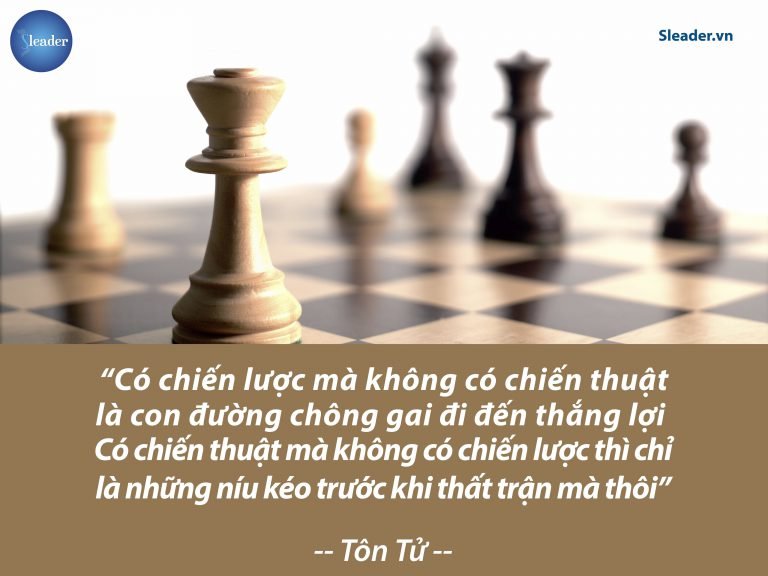
Misconceptions about strategy
In the market economy, the term “strategy” is used frequently in the business field and appears with a lot of frequency on the mass media, social networks and in everyday life. However, strategy is not always clearly and accurately understood. A deep concept is not easy to understand, easy to understand is not profound. Below, the Strategic Leadership Development Research Institute (SLEADER) introduces a concept that is both practical and easy to understand to help businesses on the right track.
Common misconceptions about strategy
In 2008, in a five-hour lecture to Vietnamese businessmen and leaders, Harvard professor Michael Porter, one of the most famous experts in strategy, pointed out the three most common types of mistakes when The definition of strategy is:
Confusion strategy and action
Many people define strategy as concrete steps. For example: Our strategy is to go international, sell to the region; The company\’s strategy is to merge with company B to form Group C.
The mistake of strategy is aspiration
Many business owners claim: Our strategy is to be number 1 or number 2 in the market; Our strategy is to grow 5 times, creating super profits for shareholders.
Confusion strategy and vision, ambition.
Our strategy is to understand, satisfy the needs of our customers, and provide premium services; Our strategy is to develop modern technology for mankind

How to properly understand the strategy
The term strategy started to be used in the military field, which is a combination of the word war (戦), meaning fight, scramble and the word strategy (略), meaning intrigue and calculation. So, understood in a simple way, strategy is the machinations, the calculations aimed at fighting and, more importantly, the victory. The strategy is to aim at the ultimate goal of victory, not at each battle, to occupy land, to keep the citadel. The best strategy is not to fight but to win (a fight becomes natural). A good general is not fighting, killing the enemy, but sitting in a spectacle but winning a thousand miles away.
Gradually, the strategy is used in other areas of socio-economic life, especially in the business sector. However, due to different approaches, many different definitions appear. Even Professor M. Porter, when criticizing common misconceptions about strategy, he did not give specific definition of strategy. Before that, in the article: What is strategy? (What is strategy), published in the famous Harvard Business Review magazine, Professor M. Porter said that strategy is the company\’s competitive advantage, it establishes the position in the market that the company wants to achieve. and figure out how different the company will need to work to achieve that goal.

The difference that M. Porter emphasized is the openness of the strategy. The argument of M. Porter is that if the strategy is not disclosed to employees and customers, the strategy will not be successful because these are the two subjects that will decide the outcome of the strategy: the employees, the longer the implementation. the customer buys the product.
In fact, because leaders of Vietnamese businesses do not understand the strategy, leaders of Vietnamese enterprises are often confused when well-planned strategies are never executed. They argue that the well-drawn strategic plans outlined in the pages of the documentation guarantee success, while not overestimating the need to take a clear, concrete step for everyone to take. use it as a light to guide difficult decisions.
A business is like having 10,000 folders and each portfolio is about an individual. If you work in a way that you keep picking up each set of files, putting in a piece of paper, you will have 10,000 sets of sheets with pieces of paper lying horizontally along different directions. Without a clear strategy, even if there are 10,000 smart people working for you, the results will only create chaos because those 10,000 people will create a series of decisions they consider right for the company.

The strategic goal should be clear, specific, quantifiable and time-limited. It is not enough to simply say, “We want to grow in a profitable way”. Between growth and profitability – what\’s more important? There may be lower goals behind the strategic goal, and these lower goals serve as a measure of progress monitoring for those individuals who are responsible. The ultimate goal is to drive activity for many years to come and this should always be clear. As such, a strategic statement would have to reflect the company\’s most core decisions regarding its goals and how to achieve them. Those decisions are threaded and consistent.
The choice of goals has a profound effect on the company. When Boeing changed its original goal from being the largest company in the aircraft industry to being the most profitable company, it had to restructure its entire organization, from manufacturing. to sales. For example, Boeing dropped its competition policy with Airbus penny in every contract and canceled its commitment to produce more than half of the largest aircraft demand in a year.
However, only making a decision about a strategic goal without clearly stating what to do and how to do it does not produce the desired result. To achieve strategic goals, it is necessary to have a strategic solution, which is determined on the basis of the company\’s core competencies as well as the constraints of the business environment. Strategic objectives and strategic solutions are always consistent, reciprocal and ensure a breakthrough if implemented strictly.

Thus, the strategy of an enterprise is a consistent series of decisions to orient the long-term future and produce great results, from which there is a qualitative breakthrough. The strategy is expressed in either a statement or an implicit form.
Strategy as a torch illuminates the development path of every business. Having a correct understanding of the strategy and declaring a clear strategy for everyone to understand will create a work consistency. On that basis, all managers and staff will have grounds to perform their roles, make choices and decisions to improve production and business efficiency and bring businesses. Sustainable Development.
Source: STRATEGIC LEADERSHIP DEVELOPMENT RESEARCH



